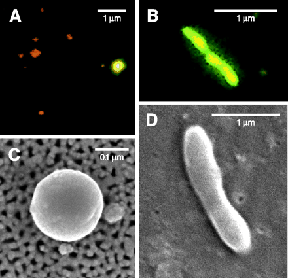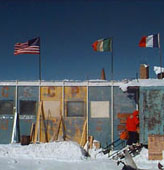
 |
|
|
Bacteria in Lake Vostok
Beneath one oasis for human life—Antarctica’s Vostok Station, where scientists work in record-breaking temperatures of negative 89°C—lies perhaps one of the last oases for life on Earth still unexplored: Lake Vostok.
In the Dec. 10 issue of Science, three independent reports piece together a puzzle that, when finished, may help explain Earth’s evolutionary history and offer clues for exploring life elsewhere in the solar system.
The Russian research facility Vostok Station is an isolated dot on the East Antarctic ice sheet and as far away from anywhere you can go without leaving the atmosphere. Its closest neighbor, the National Science Foundation’s McMurdo Station, is 1,000 kilometers to the southwest.
In 1998, scientists from the United States, France and Russia drilled
the deepest ice core recovered, which provides a 420,000-year environmental
record for the Lake Vostok region. The core is “widely held as the standard
for atmospheric and climatic variability,” wrote Robin E. Bell of the Lamont-Doherty
Earth Observatory and David M. Karl of the
University of Hawaii, in the Nov. 30, 1999, issue of EOS.
Reporting in the Dec. 10 Science, Karl and colleagues confirmed
the presence of bacteria in the Vostok ice core at a depth of 3,603 meters.

Microscopic analyses of samples from the accreted Lake Vostok ice revealed several different bacteria including: (A) a coccoid-shaped bacterium (far right), (B) a rod-shaped bacterium, (C) an SEM image of a coccoid bacterium shown at a magnification of 1.5 x 105, and (D) an SEM image of the same rod-shaped bacterium as in (B). Photo is from D.M. Karl et al. and appeared in the Dec. 10 issue of Science. |
This work complemented another ice core analysis reported
in December by a research team led by John C. Priscu of Montana State University.
Priscu’s team also found evidence of bacteria at a depth of 3,590 meters.
Both microbiological studies took special care not to contaminate the ice
during the retrieval process and both teams can be confident in the accuracy
of their findings, says Warwick F. Vincent of the Centre d’Études
Nordiques of Laval University in Canada. Vincent wrote a commentary in
the Dec. 10 Science about the recent discoveries.
Contamination is a major concern as the drill hole—separated from liquid water by about 120 meters—is filled with 60 tons of a mixture of aviation fuel and Freons to keep the hole from closing. If the drilling fluid flowed into Lake Vostok, estimates put its circulation to the bottom within days and throughout the lake within decades. Lake Vostok is about the same size as Lake Ontario but deeper, reaching more than 500 meters below a 220-meter thick layer of lake ice, and nearly 4 kilometers of glacial ice. |
The presence of bacteria near the bottom of the ice core is intriguing because the ice sampled is refrozen lake water that circulated from the lake’s bottom, according to a third report, also in the Dec. 10 issue of Science, by a research team led by French scientist Jean Jouzel. The microbes in the core, which come from the accreted ice overlying the lake, may have originally existed in the lake’s liquid portion.
If the ice core represents what may exist in the subglacial lake itself,
similar microbiota in the lake may be surviving off of an exploitable energy
source. If the energy comes from the ice above, “this lake may be one of
the most oligotrophic habitats [poor in plant nutrients and rich in oxygen
at all depths] on Earth,” Karl says. Melting or gravitational transport
would supply the lake with nutrients and an influx of other ice-bound microbes.
Another possible source of energy would be a pathway to the sea that provides
a continual flow of nutrients to the lake, which lies below sea level.
| Further research by Robin Bell of Columbia University and colleagues
may show that Lake Vostok is part of an intracontinental rift zone similar
to that of East Africa. “It’s like a lake that sits right on the Front
Range of the Rocky Mountains,” she says. Plans for 2001 include flight
surveys to map topography, gravity and magnetics of the lake and region.
The goal is to reveal if the area has classic rift morphology, to estimate
the shape of the sediments and to identify volcanics. In June, Bell and
colleagues are hoping to propose a study using ground-based seismometers
to identify earthquakes in the area.
It may be possible that Lake Vostok is heated geothermally, like the swimming pools in Iceland. “People think of East Antarctica as a cold stable craton,” Bell says. “This is not necessarily the case—it may be an active rift.” —Christina Reed |

The study of Lake Vostok is a collaboration of American, Russian and French scientists. Photo is from Al Sutherland, National Science Foundation. |